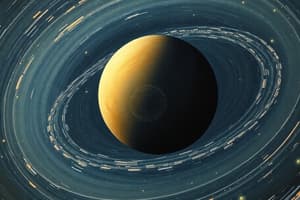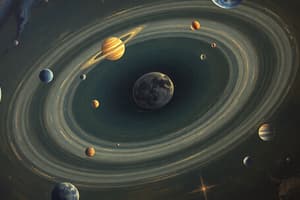Podcast
Questions and Answers
What was Kepler's First Law?
What was Kepler's First Law?
Planets revolve around the Sun in elliptical orbits with the Sun at one focus of the ellipse.
Which of the following does Kepler's Second Law support?
Which of the following does Kepler's Second Law support?
When a planet is closer to the Sun, its speed is greater than when it is farther away.
What was Kepler's Third Law?
What was Kepler's Third Law?
The square of the time period for an orbit of a planet is proportional to the cube of its average distance from the Sun.
About how many times does Earth orbit the Sun in the time it takes Saturn to orbit just once?
About how many times does Earth orbit the Sun in the time it takes Saturn to orbit just once?
What would happen if the ozone layer were completely destroyed?
What would happen if the ozone layer were completely destroyed?
In the image of the Moon shown, identify which of the labeled regions correspond to maria and which ones correspond to terra.
In the image of the Moon shown, identify which of the labeled regions correspond to maria and which ones correspond to terra.
From the Apollo astronauts' descriptions, what is the lunar surface physically like?
From the Apollo astronauts' descriptions, what is the lunar surface physically like?
Which type of lunar surface is relatively young compared to the other?
Which type of lunar surface is relatively young compared to the other?
Which of the following is/are caused by dense atmospheres?
Which of the following is/are caused by dense atmospheres?
How can we tell the Moon does not have a substantial atmosphere?
How can we tell the Moon does not have a substantial atmosphere?
Why did astronauts walk on the surface of the Moon with slow hops?
Why did astronauts walk on the surface of the Moon with slow hops?
What chemical compound gives the Martian soil its distinctive color?
What chemical compound gives the Martian soil its distinctive color?
The distribution of craters on Mars can be best described as?
The distribution of craters on Mars can be best described as?
What general conclusion can we draw about the history of Martian geology?
What general conclusion can we draw about the history of Martian geology?
What is known about the formation of Valles Marineris?
What is known about the formation of Valles Marineris?
What evidence do we have that suggests Mars was once much wetter than it is today?
What evidence do we have that suggests Mars was once much wetter than it is today?
Which of the following could be the reason that Mars has only a thin atmosphere?
Which of the following could be the reason that Mars has only a thin atmosphere?
Flashcards are hidden until you start studying
Study Notes
Kepler's Laws of Planetary Motion
- Kepler's First Law states that planets move in elliptical orbits with the Sun located at one focus of the ellipse.
- Kepler's Second Law indicates that a planet's speed varies; it moves faster when closer to the Sun and slower when farther away.
- Kepler's Third Law presents the relationship ( P^2 \propto a^3 ), where the square of a planet's orbital period (P) is proportional to the cube of its average distance from the Sun (a).
Orbital Mechanics
- Saturn orbits the Sun approximately once in the time that Earth completes about 30 orbits, due to its greater average distance from the Sun.
Atmospheric and Lunar Surface Studies
- If the ozone layer were entirely depleted, increased ultraviolet radiation would pass through the atmosphere, posing dangers to living organisms.
- The Moon's surface is predominantly covered with fine dust, as described by Apollo astronauts, indicating a lack of substantial atmosphere.
- The Moon has no notable atmosphere, as it does not scatter sunlight adequately; thus, the lunar sky does not appear bright.
Lunar Features
- In early astronomical terminology, regions on the Moon identified as terra (land) include areas labeled C, B, E, while maria (seas) are identified as A, D, and F.
- The dark lunar maria are determined to be younger than the bright highlands, which are subjected to more impact craters.
Martian Geology
- Martian soil has a distinctive red coloration due to the presence of iron oxide.
- The distribution of craters shows that the Southern Hemisphere of Mars is heavily cratered, indicating an older geological surface compared to the Northern Hemisphere, which is relatively smooth.
- Evidence suggests that the southern highlands are significantly older than the northern lowlands that lack craters.
Valles Marineris Formation
- Valles Marineris was formed through various geological processes, not just a single formation process, indicating a complex geological history.
Martian Water Evidence
- Features such as outflow channels and subsurface water ice indicate that Mars was once a much wetter planet than it is currently.
Martian Atmosphere
- Mars has a thin atmosphere likely due to its insufficient gravity to retain a thicker atmosphere over time, allowing atmospheric gases to escape into space.
Studying That Suits You
Use AI to generate personalized quizzes and flashcards to suit your learning preferences.




